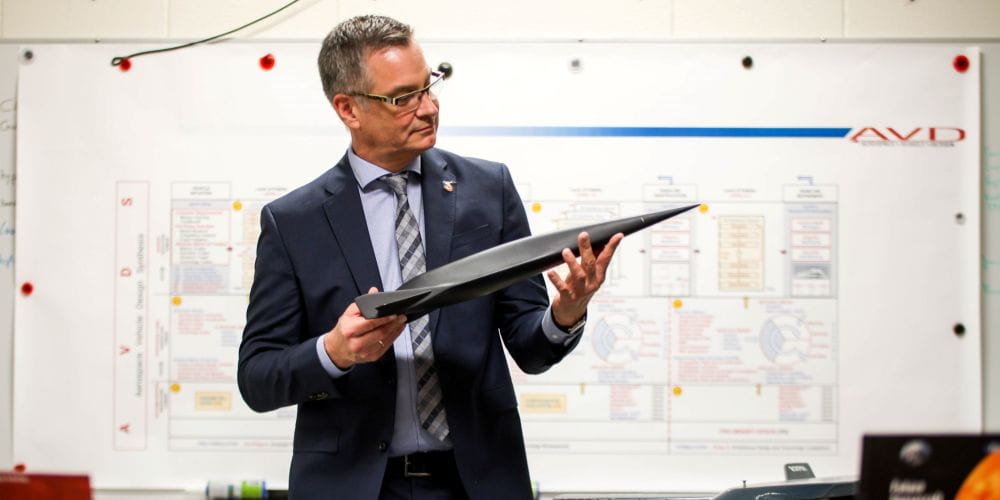
Today, large commercial jets fly around 580 mph. The Lockheed SR-71 Blackbird introduced in 1966 is the fastest supersonic jet vehicle in the world, reaching speeds of more than 2,200 mph, nearly four times faster than a commercial jet.
The fastest rocket-powered hypersonic vehicle developed in the late 1960s carrying a human has been the North American X-15, reaching a top speed of 4,520 mph, twice that of the SR-71.
Recently, the U.S. Air Force has awarded a contract to engineer Project Mayhem with the goal to reach 4,603 mph. Now, imagine a vehicle that could fly much faster, maybe even above 6,905 mph, which is beyond nine times the speed of sound.
The University of Texas at Arlington's Aerospace Vehicle Design (AVD) Laboratory has a team of graduate aerospace engineering researchers that has been tasked to design a military hypersonic missile system to fly at speeds previously only encountered by NASA's X-43A, Hyper-X. This system would fly faster and further than any other air-breathing vehicle in history. The development of the conceptual design of this hypersonic missile at UTA will showcase how every university should approach hypersonic vehicle design and forecasting.
Bernd Chudoba, UTA aerospace engineering professor and director/founder of the AVD Laboratory 20 years ago, is leading the high-pressure five-month project through a grant from Parallax Advanced Research. The title of the project is "Solution Space Screening for Leap Forward Initiative for Hypersonic Vehicle Conceptual Analysis, Design, and Technology Forecasting."
"This is a monumental opportunity for UT Arlington," Chudoba said. "Parallax is pursuing a novel high-speed concept that will offer the warfighter a new capability to meet mission objectives. Overall, we will determine and validate the most promising concepts and the current technology needed for the next generation of hypersonic missile systems to fly."
The AVD Laboratory is the only place in the United States to accomplish this task, said officials with Boeing, NASA and the USAF. It offers an impressive history of aerospace vehicle design research experience addressing innovative methods and processes focusing on forecasting hypersonic vehicles.
Chudoba has worked with the industry Future Project Offices of EADS Airbus GmbH, Airbus UK (British Aerospace), Airbus France (Aérospatiale Aéronautique), Airbus Industrie and Fairchild Dornier in Europe. The AVD Laboratory was founded in 2002 with the sole goal of advancing the stagnant industry Future Project Office capabilities worldwide. This focus is not typically found in a university environment. As such, customers and partners rely on the trailblazing research environment the AVD Laboratory delivers.
Chudoba's research focuses on the multi-disciplinary and multi-fidelity aerospace science and engineering domains, which are targeting professional applications. The focus within the vehicle design process surrounds the conceptual design phase and transition into the preliminary design phase.
The team's motivation is the advancement of the unique "digital engineering" synthesis methodology and AI software AVDS (Aerospace Vehicle Design Synthesis), developed by the AVD Laboratory during the past 20 years.
In collaboration with NASA, the Air Force Research Laboratory, the Air Force Office of Scientific Research and others, the AVD Laboratory focuses on the verification, application and advancement of AVDS. These collaborations have produced the most advanced hypersonic vehicle design framework in the United States, enabling unrivaled design-to-mission capabilities.
"What the United States is trying to do is not only protect its homeland but also get ahead and beyond America's rivals in this field," Chudoba said. "The Parallax-UTA Partnership is structured to design, build and fly an experimental hypersonic missile faster and further than anyone else, not just put it in a hypersonic wind tunnel."
Erian Armanios, professor, and chair of the Department of Mechanical and Aerospace Engineering, said Chudoba's project has the opportunity to be expanded in the future.
"'Think hypersonic'; that's our adage as we equip our students to compete and win this race," Armanios said.






